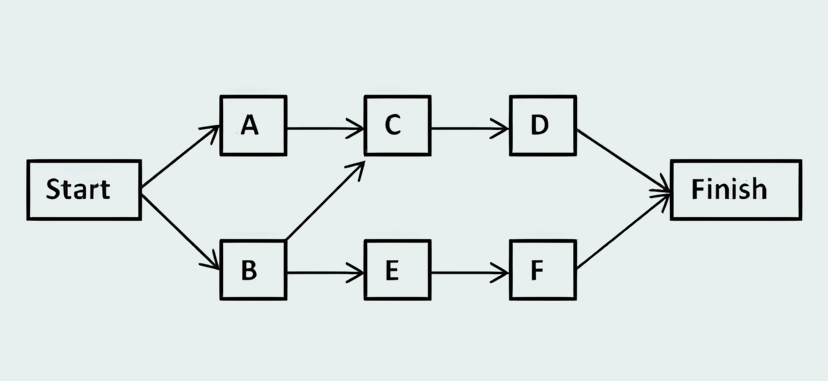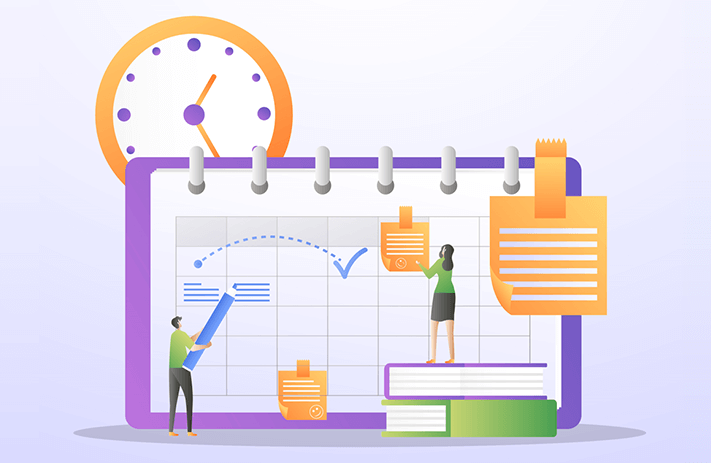
Click the button to start reading
Need help scheduling your project? Try the Precedence Diagramming Method.
Project management can make tasks of any scale more streamlined and efficient. But as a project grows in size and complexity – or perhaps you have multiple projects to schedule? – a visual tool to help you understand the dependencies between tasks becomes more important. That’s where Precedence Diagramming Method (PDM) comes in.
PDM is a project management tool that can help map a relationship between project tasks. It helps project managers establish a visual representation of the project’s timeline.
Want to learn how to use this method on your project? Today, we’ll take a closer look at PDM and explore how it can help you effectively manage your projects.

What is the Precedence Diagramming Method?
Let’s start with some basics – what is the precedence diagramming method? In project management, you can think of Precedence Diagramming Method (PDM) as a visual assistive tool that helps project managers schedule. The technique uses boxes or nodes to represent tasks with lines and arrows representing their relationship or dependencies.
To create a precedence diagram, you map out all tasks, order them, determine their dependencies, and draw them out (more on how to draw a dependency diagram below).
Unlike other project network diagrams, Precedence Diagramming Method is a nodal/activity-on-node (AON) method that emphasizes tasks over, for example, milestones, like in an AOA diagram.
Project managers ultimately use a PDM to create a project schedule network diagram.

Benefits of Precedence Diagramming Method
What makes it worth the time to map out all your tasks and their interdependencies ahead of time? Here are some of the benefits of using the Precedence Diagramming Method in project management.
- AON, not AOA. As an activity-on-node (AON) method, one of the main benefits is that you’ll have the space in the nodes to add detail like duration, resources, or constraints.
- Accurate scheduling. Like any project management technique, PDM can help you create more accurate scheduling and timelines for your project by bringing visual attention to the duration of or dependencies between tasks.
- Visual. Because PDM is a diagram, it visually illustrates your project’s tasks. This view can shed light on things you might otherwise miss.
- Determine critical paths, relationships, and dependencies. PDM uses arrows flowing in different directions to show the relationship between projects, but it also accounts for different types of dependencies – for example, a reliance on factors outside of your control. This view can help you understand how to order tasks for more efficient projects.
- Priorities, assignments, identify missing activities. Finally, PDM can help you prioritize by showing you which tasks or assignments are most critical to project completion. By directing your focus toward the essential tasks or starting early on tasks that are outside of your control, you will have a better handle on your overall project timing.

How to Draw a Project Schedule Network Diagram Using PDM
As we mentioned above, the Precedence Diagramming Method is one possible starting point for creating a project schedule network diagram.
You’ll have nodes (activities) and arrows (dependencies). Before we walk you through the steps of how to draw a project schedule network diagram, you’ll first want to understand the different types of activity relationships and dependencies.
Activity Relationships in Project Management
There are four different types of task dependencies: Finish-to-Start, Finish-to-Finish, Start-to-Start, and Start-to-Finish. In your diagram, the different types of dependencies will be indicated by the direction of the arrow.
So what is each type of dependency? We’ll explain below using “Task A” and “Task B.”
- Finish-to-Start (FS) Dependency: Finish-to-Start Dependency is perhaps the most common type of task dependency. It’s an arrow from Task A to Task B that indicates Task A must be completed before Task B can begin. An example of a FS dependency is a design project – the brand guidelines (Task A) must be completed before the web designer can start building the website (Task B).
- Finish-to-Finish (FF) Dependency: Finish-to-finish dependency means that someone can only complete Task A after Task B has been completed. With this dependency, both tasks may be running side-by-side, but the key is that one can only be completely finished when the other is done. An example could be the first sale in a product launch. You can run marketing activities concurrently, but the first sale can only be completed once the first product is back from the manufacturer and ready to be shipped.
- Start-to-Start (SS) Dependency: Start-to-start dependency is a less common type. It means you can only start Task A once Task B has started. Task A cannot begin before Task B, but they don’t necessarily have to start simultaneously. An example of SS dependency is a house renovation where the electrical wiring has to be started before the first lights can be hung.
- Start-to-Finish (SF) Dependency: Start-to-finish dependency says that Task B cannot be completed until Task A starts, and vice versa. Most often, this type of dependency is related to resources, materials or information. A straightforward example is shift work – you can think of it as one person unable to finish their day until the next person arrives.
Types of Dependency in Precedence Diagramming Method
There are also four types of dependency in PDM: Mandatory Dependency, Discretionary Dependency, External Dependency, and Internal Dependency. The different dependency types will also impact your planning and scheduling, so you’ll want to go through the list below before drawing your arrows.
- Mandatory Dependency or Complex Logic. As the name suggests, mandatory dependency is when a dependency is compulsory. You can think of this as a dependency where one task wholly can’t proceed without the other. An excellent example of mandatory dependency would be client approval of a first draft. Once it’s been submitted, there’s no further work to do on the project until you get feedback.
- Discretionary Dependency or Soft or Preferential Logic. Discretionary dependency is a lighter dependency. It’s also called preferred Logic, preferential Logic, or soft logic. A discretionary dependency focuses on optimization for a better result. The dependency of tasks might be based on past experience or best practice, but it’s not critical that you complete one before moving to the next. The good thing about discretionary dependency is that it’s flexible and allows adjustments to accommodate schedule changes, etc. An example of discretionary dependency is a team rolling out a development project. They might find it’s better to introduce Feature A before Feature B, but this is flexible if Feature B is finished early or the client’s needs change.
- External Dependency: External dependencies refer to anything outside of the control of the project or team that your project depends on. These external dependencies might be government funding, investment, permitting, etc. These are things outside the project manager’s control, and if there are delays or roadblocks, they can derail a project. One example of an external dependency is a back ordered piece of equipment. You can place the order and pressure the supplier, but ultimately you have to wait until the delivery date to begin your work.
- Internal Dependency: Internal dependencies are between two project tasks. Typically, these are entirely under the control of the project team. This could be that one team member can’t start working on their task until the previous project finishes. In an example of a house, a room can’t be painted until the walls are finished.
When it comes to dependency levels, two are applicable at any time. The possible pairings are…
- Mandatory-External
- Discretionary-External
- Mandatory-Internal
- Discretionary-Internal
Drawing a Dependency Diagram
Now that you understand the activity relationship and dependency types, let’s talk more about how to draw your dependency diagram.
- Create a task list. Like most project management techniques, creating a task list is the first step. You can either do this for the whole project or a single section. Once you’ve listed the tasks, you might also begin to sequence them based on a perceived order.
- Identify dependencies. With a task list in front of you, you can start to identify dependencies between tasks. This is the stage where you’ll classify tasks as FS, FF, SS, or SF. You’ll also want to determine if the dependencies are mandatory, discretionary, internal or external.
- Put it into a diagram. Now that you’ve identified all your tasks (nodes) and dependencies (arrows), you can start drawing out your diagram. Write out your tasks in boxes that move left to right. If the tasks have the same predecessor, you can stack them on top of each other. Then, each box should be connected to the next using an arrow reflecting their dependency.
- Add task information or duration. One of the key benefits of an AON diagram is that it leaves space for more detail on your task. In each node, you might include more information like the float or slack time, earliest start time, earliest finish time, latest start time, or latest finish time
Different Types of Project Network Diagrams
Want to understand how Precedence Diagramming Method compares to other project network diagrams that you can use to help with scheduling? Here are a few different methods you might consider for your team.
Arrow Diagramming Method
Arrow Diagramming Method is an activity-on-arrow method. In this case, the tasks are represented by arrows, while the relationships or dependencies are nodes or circles that connect the arrows.
With the Arrow Diagramming method, you can use the length of the arrow to indicate how long the activity will take. The biggest drawback of this method is that it only shows finish-to-start relationships.
Critical Path Method
The critical path method helps you identify tasks necessary for project completion. It is the longest sequence of activities required to finish the project. It’s possible to use CPM after you’ve created a precedence diagram.
Gantt Chart
The Gantt chart is a project scheduling technique that looks like a bar chart. Activities are bars of different lengths, and they’re organized in chronological order.
That just about covers it! If you’re looking for a technique to help with project scheduling, we think you’ll find the Precedence Diagramming Method to be one of the most visually simple and organized ways to do it. Happy scheduling!
















